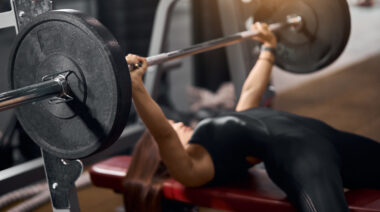Looking for a simple and powerful way to strengthen your core while stretching your central pillar? Your central pillar is your hip-to-shoulder zone. Look no further, the resisted rock will do it. A key to this movement is continuous engagement of the core during the concentric and eccentric phases of the motion.
The key to performing the resisted rock is to maintain a backwards pull of your hands toward your knees.
Breathe for Stability
When we think of movement, we tend to focus on how muscles produce motion. However, the abdominal muscles both produce and prevent motion. They play a fundamental role in stability of the pelvis and lower back.
Training the hip-to-shoulder zone is important because a strong core is critical for stabilizing the body during heavy lifts, daily activities, and sport-specific movements. The abdominal wall consists of four muscles: rectus abdominis, external obliques, internal obliques, and transverse abdominis.
You can mix the resisted rock into any workout for a great stabilization exercise and warm up. Though it seems like a simple exercise, it can be challenging to perform with good technique and proper breathing. One of the biggest compensations during the resisted rock is holding of the breath for stability. If you don’t own breathing, you don’t own movement. So pay close attention to maintaining a normal breath cycle.
I recommend doing your mobility work prior to performing the resisted rock. Increasing mobility and then locking it in with stability is a powerful combination. It doesn’t matter where the mobility restrictions are – ankle, hip, thoracic spine, wrist, or soft tissue. Release the mobility restriction, and then add the rock.
Are You Ready to Rock?
Breakdown of the rock:
- Get on hands and knees. Hands below the shoulders and knees below the hips. Open up knees so they widen to line up with outside margin of the hips.
- Dorsiflex ankles and spread fingers out wide.
- Pull hands back toward the knees, but do not let the fingers slide on the ground. Pulling back engages the central pillar.
- While maintaining the pull, slowly rock back toward your heels, taking a minimum of four seconds. Get your glutes as close to the feet as possible.
- Moving slowly, take a minimum of four seconds to rock forward while maintaining a backward pull of your hands toward your knees. Keep moving forward until your shoulders are in line with your fingertips. Never stop pulling.
That’s one repetition. Repeat the pattern 4 times for 3 rounds, for a total of 12 repetitions.
What to watch for:
- Maintain a neutral neck. Do not flex or extend the head. Maintain an eyeline with the floor.
- Do not hold your breath. If you do, repeat the motion. If it’s still too difficult, shorten the distance you rock, or pull with less pressure on the hands.
- Ensure your shoulders reach the fingertips at the top of the movement. You may find this the most difficult position to breathe in.
- You can plantar flex, or relax the ankle if you feel discomfort in the toes. This will also allow you to sit further back into the rock.
- If the arms fatigue before all repetitions, simply relax the arms and do a few rocks without tension. Then resume the count.
Quality Over Quantity
Many people have the tendency to do high-repetition training for the abdominal muscles, but there is no need for crazy-high reps. The abs are just like any other muscle group. In order to improve strength and definition, you have to load them up. Doing endless reps will not get you the results you want.
You will probably find yourself extremely sore after your first round of resisted rocks. You will also notice an increase in the strength and flexibility of your central pillar. Don’t let the simplicity of this exercise fool you.
More Raw Strength From Coach Nickelston:
- Take Your Strength to the Next Level with Ipsilateral Crawling
- Unleash Hellacious Power With the Tall Kneeling Unilateral Pull
- Can’t Touch Your Toes? Find and Fix the Root of the Problem
- New on Breaking Muscle Today
Photos courtesy of Perry Nickelston.






